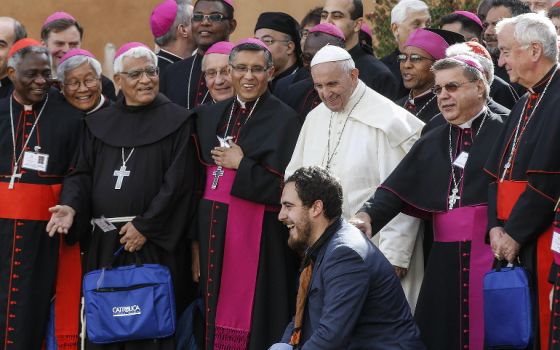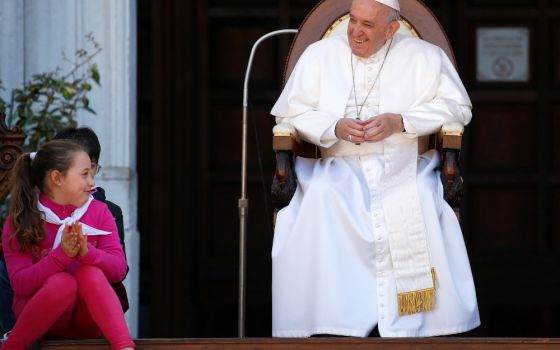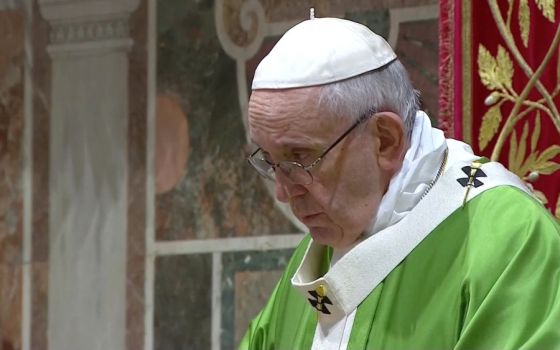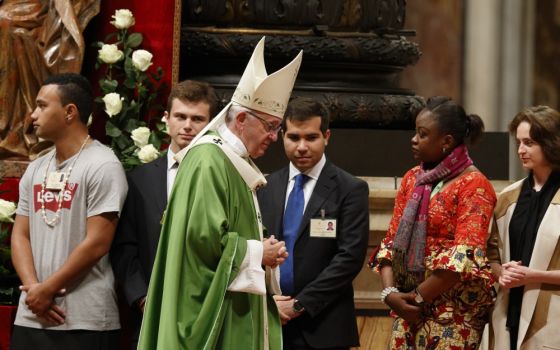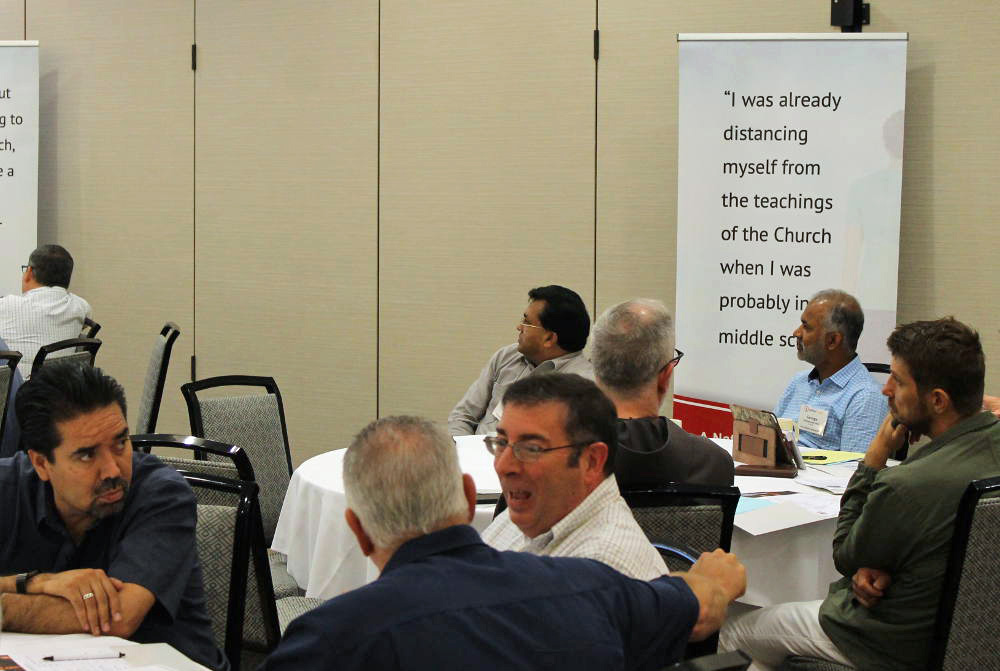
Participants at the annual assembly of the Conference of Major Superiors of Men react to research on why young Catholics have disaffiliated from the church during a workshop July 31 in St. Louis. (NCR photo/Brian Roewe)
Plastered on posters, the reasons why young Catholics have foregone their faith surrounded the conference room here inside a hotel in the St. Louis suburbs.
"Catholicism was forced on me as a young child. It was not something I ever wanted to do," Holly said.
In Edward's case, "I don't think of myself as religious or spiritual. I consider myself to be a good person."
As for Grace, "I actually feel OK not having an attachment to the Catholic Church — it's a little weight that is taken off."
The testimonials, along with a series of surveys and studies, set the stage for conversations throughout the four-day annual assembly (July 31-Aug. 3) of the Conference of Major Superiors of Men. The primary organization for U.S.-based male religious orders organized their gathering with an eye to the synod on youth and young adults Pope Francis has convened for October at the Vatican.
The questions around young people's engagement with the Catholic faith loom for all corners of the church, including for religious orders dependent on new vocations to continue their charisms.
"They're looking for a home," Marist Br. Sean Sammon said of young Catholics. "And they're wondering whether the church can provide that. I think it can, but I think that's where we need to provide a different face of the church sometimes."
Capuchin Fr. John Pavlik, CMSM executive director, told NCR he's "learned to pay attention to big moments" in the life of the church, with the exodus of young disaffiliated Catholics one such moment. To him, it also represents a periphery for where the church must go.
"It's Jesus in the Gospels we're talking about here. … Where did Jesus go? To where the problems are, where the people are suffering, where the hurting is," Pavlik said.
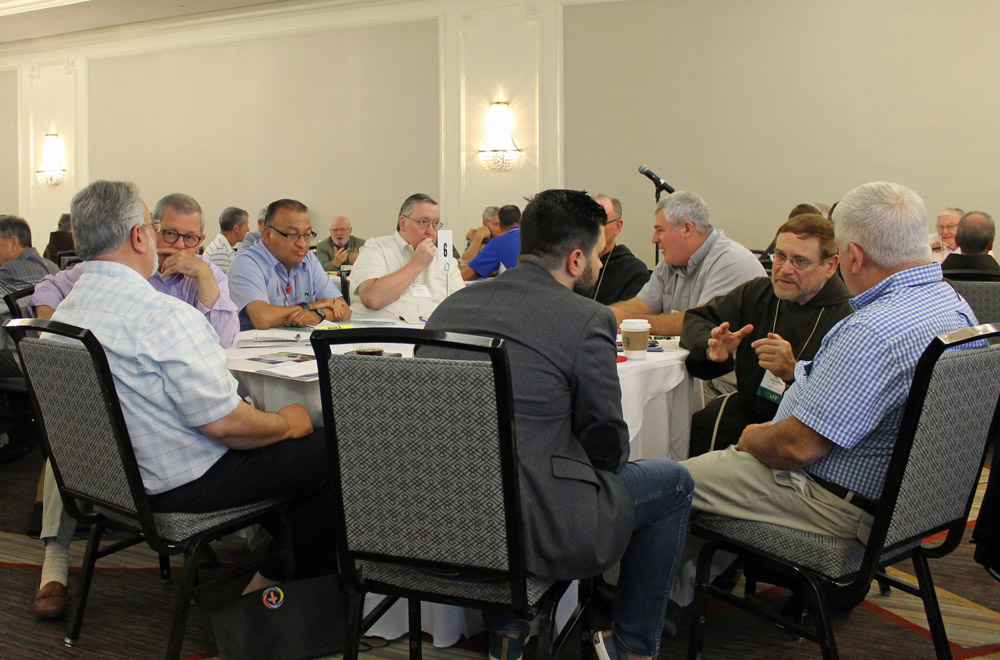
CMSM executive director Capuchin Fr. John Pavlik, second from left, speaks with fellow attendees at the annual assembly of the Conference of Major Superiors of Men, held in St. Louis. (NCR photo/Brian Roewe)
New creation in 'chaos'
A pre-conference workshop July 31 devoted a full day to examining why young people are leaving the church in the first place.
Serving as a foundation was the "Going, Going, Gone" study that surveyed 15- to 25-year-old former Catholics published by St. Mary's Press in January. Along with the quotes around the room, several videos allowed young people to speak for themselves why they've headed for the exits.
"About two years ago or so, I just, my way of thinking just kind of shifted, and I just started believing on my own," said Beatriz. "I believe in a higher power, definitely, but I don't believe in organized religion altogether, because I believe it segregates people instead of bringing them together. There's a lot of good points in the Bible that you can refer to, but I believe that the real meaning of the Bible, if it's the truth, it's been lost in translation."
While the present moment presents many challenges, Bob McCarty, the study's co-author and project coordinator, described it as "an exciting time" for church ministry, "especially if you like chaos."
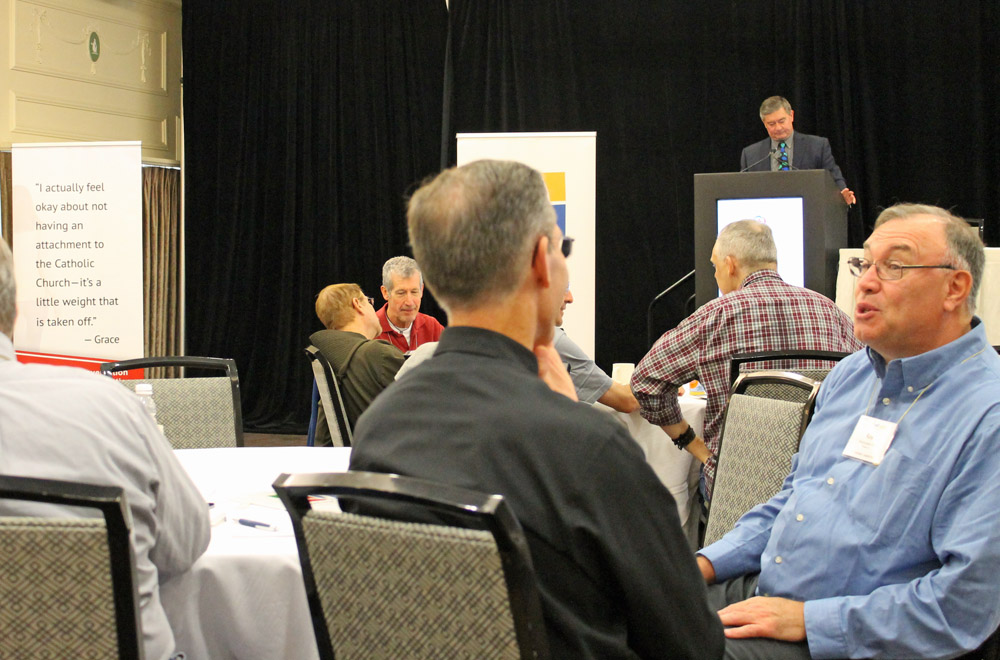
"Young people are kind of my window on the church, on the wider church," said Bob McCarty, pictured here behind the podium. McCarty is co-author to the "Going, Going, Gone" study on disaffiliated young Catholics, published by St. Mary's Press. (NCR photo/Brian Roewe)
"I find the spirit of God present in the chaos," he told the audience of religious, that "in the chaos we will find the seeds of new creation."
McCarty, who has worked in professional ministry for 45 years, much of it with youth, put forward the analogy of maps — that they only work when they match the territory. In terms of ministry to young people, the territory "has changed rapidly," he proposed, "and if we try to read that territory with old maps, we're not going to be effective."
Examples he highlighted of old but now ill-fitting maps were ones that point to young people succumbing to a secular and materialistic culture, that suggest fault in the parents, or that place the solution in better catechesis of what the church believes.
Instead, McCarty suggested a map that reads, "Our young people today are searching desperately for a compelling vision of what it means to be human, and maybe they're not finding that vision in church circles."
Within the room, the dozen or so young adults in attendance became popular sources to confirm or expand on the information presented about their peers.
Emma Lii, a student at the University of Washington and peer minister at its Catholic Newman Center, said she found it refreshing her perspective was sought out. She has found among her fellow young Catholics an eagerness to raise questions freely about their faith. She agreed with an observation from the "Going, Going, Gone" study about "going deeper quicker," in terms of addressing important issues at earlier ages — highlighted by the study's median age of 13 for disaffiliating.
"I totally agree with that. … I think young people really do have questions, they just don't know how to ask them," she told NCR.
Howard Stamps III, a young adult who met with clergy during a program on racial justice at St. Alphonsus Liguori Church, said young people want more community development from the church.
At his parish of St. Elizabeth, Mother of John the Baptist, where he assists with youth ministry, Stamps said they "involve our youth in any way and capacity that we can," whether through service projects, youth groups and on the parish council. "Just giving them some way of feeling like they belong," he said.
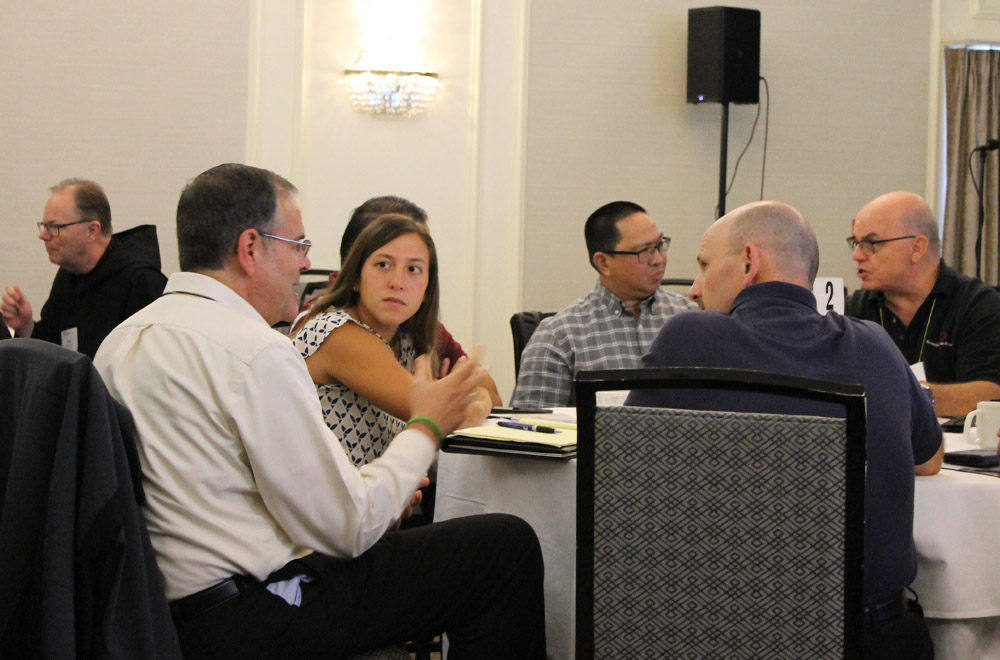
Abby Michels, a young Lasallian Coordinator for the Christian Brothers of the Midwest, discusses outreach to young Catholics during the annual assembly of the Conference of Major Superiors of Men, held in St. Louis. (NCR photo/Brian Roewe)
Critical questions, no single solution
Community and accompaniment were consistent themes throughout the conference. One definition of community put forth, attributed to Rabbi Jonathan Sacks, had a "Cheers"-esque ring to it: a place where people know who you are and where they miss you when you're gone.
While young people are leaving organized religion, their search for meaning and purpose still often leads to some type of community. John Vitek, co-author on "Going, Going, Gone" and president of St. Mary's Press, at one point noted the growing popularity of CrossFit workout gyms, not just as a place to get in shape but to forge relationships.
The researchers raised three critical questions for doing transformative ministry to estranged young Catholics: Who are the disaffiliated? Are they missed? And do they know they're missed?
To the first question, conference attendees were asked to introduce one another to a young person they know who no longer identifies as Catholic. Bobby Pantuso, a lay Salvatorian and associate vocations director for the Society of the Divine Savior, in Milwaukee, recalled a longtime friend who grew up Catholic but fell away in his teens after his father, himself a "good Catholic" who attended Mass every Sunday, got very sick and died.
"I don't know what I can say or whatever to get him back," he said.
McCarty cautioned there is no single clear map or "silver bullet" solution to bring back those who've left or prevent further losses, and that research reveals no singular reason for why young Catholics disaffiliate.
The "Going, Going, Gone" study found church scandals and specific church teachings appeared less of factors for youth in disaffiliating than many might assume; more prevalent were a disbelief in God or religion and the view that you can live a full and meaningful life without religion.
Still, McCarty highlighted same-sex marriage as a key issue for the segment of "dissenters" — something they view in terms of justice and human rights rather than sexuality, with the church's opposition hypocritical in light of its advocacy for human dignity.
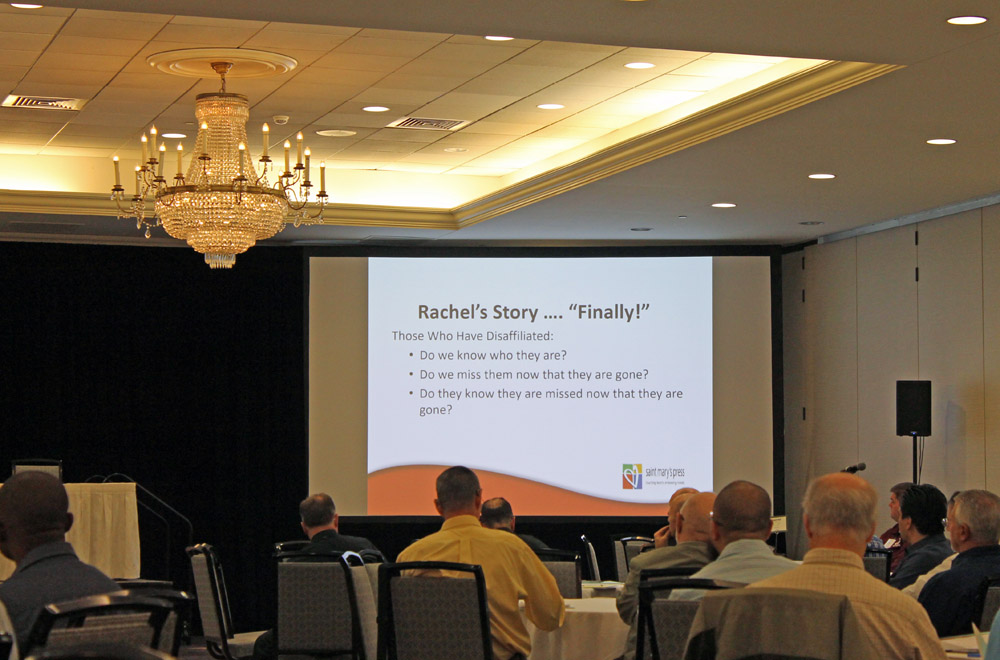
"We need to start thinking about who are the disaffiliated?" said Bob McCarty, project coordinator for the "Going, Going, Gone" study. "Do we know who they are by name? Do we miss them, now that they're gone? And do they know they're missed?" (NCR photo/Brian Roewe)
Observations and frustrations
In table discussions and side conversations, clergy and lay participants attempted to digest the data and stories, in terms of what they mean for the future of the church and for vocations to their various religious orders.
Some readily recognized a need for greater accompaniment with young people, the idea of listening to listen and learn, rather than listening to respond. One priest observed in many of the featured young people a Catholic element still present, asking, "Do we want to let that go?"
Sammon, a former CMSM president and superior general of the Marist Brothers who now works at Marist College, in Poughkeepsie, New York, found it "incredibly hopeful" that young people are asking questions and searching for deeper meaning.
"To me that's very connected to what faith would be about. But I think we have to find a new vocabulary," he said.
Franciscan Fr. Gregory Plata told NCR he saw young people seeking a more welcoming and authentic church. Understanding their dissatisfaction with institutions, he described how the choices youth today have in forming their own spiritual identities differed with his upbringing "marinated as a Philadelphia Catholic."
"My whole world was presented as the way that the church saw it. … It's a whole different model that they grow up in from what I grew up in," he told NCR.
Still, other clergy expressed frustration with the stories of why young Catholics have left. Some were skeptical of the research's credibility and questioned whether they should even care what the disaffiliated have to say.
"A la carte Catholics" was one comment. Others said the problem with young people is they're ill-informed and undereducated about what the church teaches.
A young Franciscan friar wondered aloud why these young people, present for a blip of the church's 2,000-year history, should get to decide how and if it changes. He likened not correcting views inconsistent with church teaching to allowing a child to keep their hand on a hot stove.
Br. Javier Hansen, one of the three U.S. youth delegates to a March pre-synod youth gathering in Rome, said his takeaway from that event was the church has "a huge responsibility to better teach the faith."
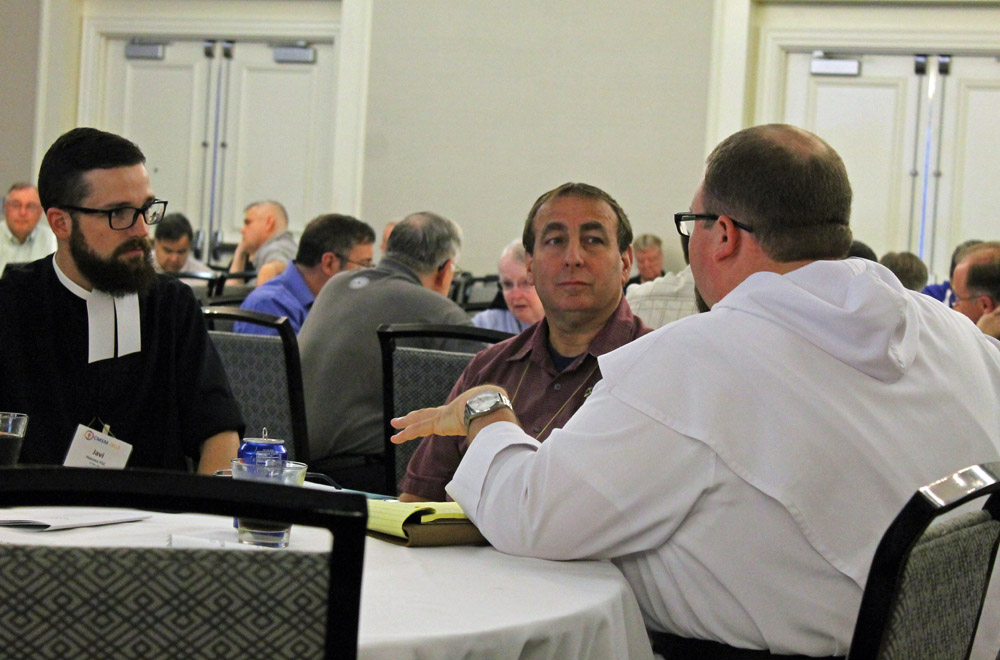
LaSallian Christian Br. Javier Hansen, left, discusses a speech by Tulsa Oklahoma, Bishop David Konderla during the annual assembly of the Conference of Major Superiors of Men Aug. 1. In March, Hansen was among three U.S. delegates to gathering of young people in preparation for the synod on youth and young adults. (NCR photo/Brian Roewe)
Voicing concerns shared by others, Hansen asked Bishop David Konderla of Tulsa, Oklahoma, during a Q-&-A session Aug. 1 "how to balance empathetic listening and remaining faithful to the church and the catechism and what the church teaches?"
"I think that knowing where we're going is essential to us being able to be leaders," Konderla responded. "So we're listening, but not because we don't have any direction, not because we don't have a sense of where we think Christ is, but precisely because we do have that."
The 58-year-old bishop focused his talk on his impressions from 11 years (2005-2016) as pastor of St. Mary's Catholic Center at Texas A&M University. He described the goal of campus ministry as helping young people have an encounter with Jesus, and stressed Francis' call to accompany them.
Konderla encouraged religious communities to collaborate — among themselves and with dioceses — and offered suggestions on how to meet young people where they're at, spiritually and geographically, from attending youth events and being present in places where they gather, to involving them more in ministries and organizing retreats and road trips — such as a "nun run" to visit area convents.
What doesn't work in reaching out to youth, Konderla added, was clericalism, condescension, inauthenticity and judgement.
"They're pretty sensitive about being judged, so we have to be really careful about our own ambiguity tolerance," he said.
Advertisement
Seeing challenge as grace
McCarty challenged the church not to see young people as a problem to be solved but a "grace" as a kind of window on the wider church. "What's the Holy Spirit telling the church through the lives and through the stories of those who have disaffiliated?"
"This is not a youth issue. What we have is a faith community challenge," he said, noting that the 5.4 million disaffiliated young Catholics (between ages 15-25) represent just a slice of the 30 million former Catholics overall. To that end, he warned about ignoring the "Catholic-ish" or "Catholic-adjacent" of all ages still in the pews but pondering their own exits.
Lii, the student at the University of Washington, said she hopes the synod will provide the church an avenue to address issues that young people have.
"From what I feel right now, the church seems very stagnant," she said. "I think we're kind of stuck, because a lot of what we do is tradition, obviously, and that's still very important, but I think in order for the church to improve, there needs to be actual change that occurs and happens."
Sammon said he was encouraged by the instrumentum laboris for synod, and hopes it results in a process that recognizes young peoples' experiences and puts forth a plan to engage them with the church "to kind of create a future together."
"I think just publishing a document is not going to be particularly helpful unless the document has a certain practicality to it," Sammon said.
Pantuso, the Salvatorian vocations director, said the data on disaffiliated Catholics can help the church begin asking self-reflection questions about why people are leaving and how it can become more welcoming. The situation reminded him of a quote from "The West Wing" about a leader with no followers — just a guy taking a walk.
"A priest without a flock is just a guy out for a walk," he said. "So I don't know, I think we need to change the conversation, we need to ask the right questions and I think we need to be inclusive."
[Brian Roewe is an NCR staff writer. His email address is broewe@ncronline.org. Follow him on Twitter: @BrianRoewe.]





